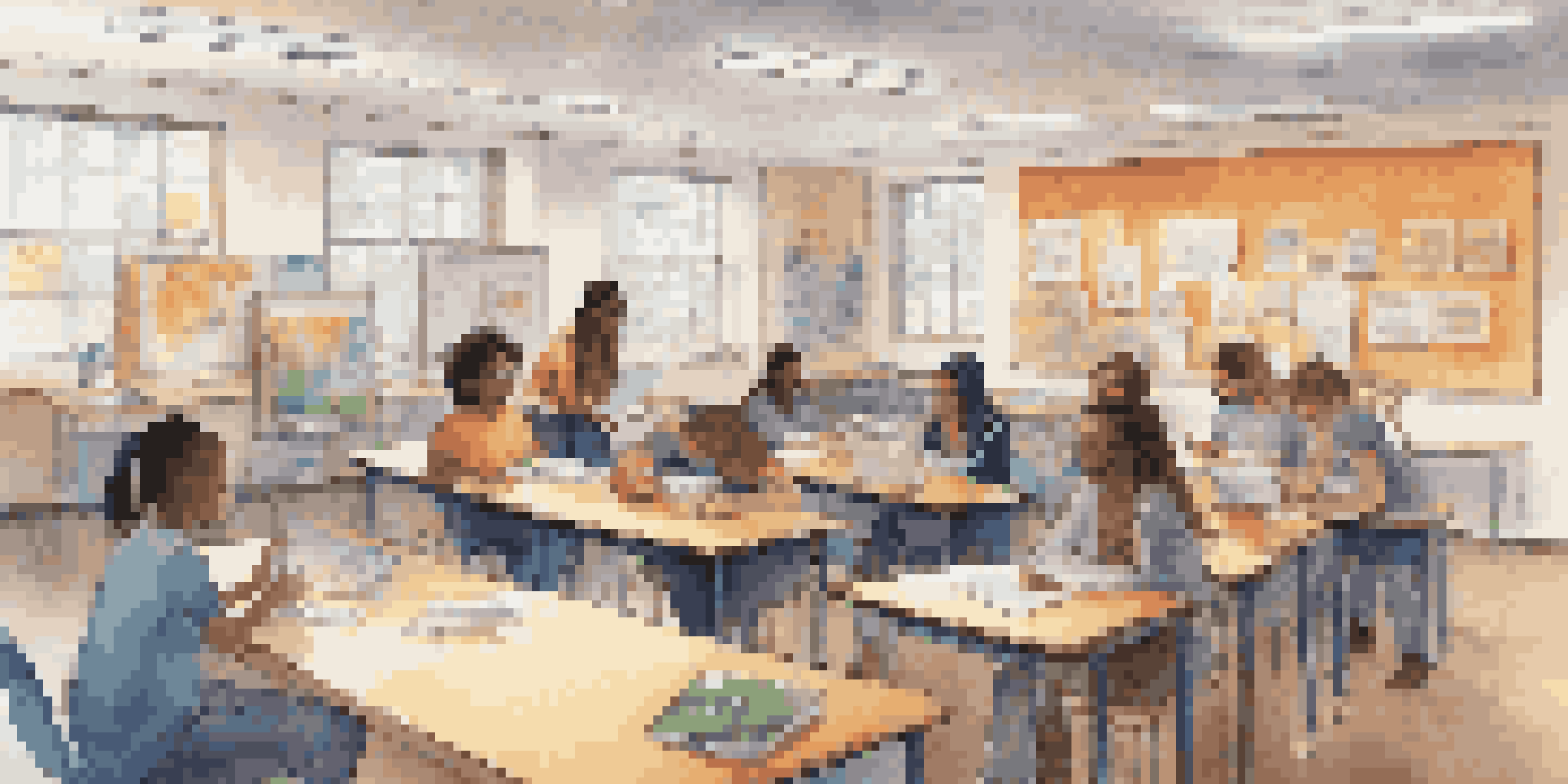The Role of Educators in Supporting Diverse Learning Needs

The Importance of Recognizing Diverse Learning Needs
Educators play a crucial role in identifying the various learning needs of their students. Each child comes with unique backgrounds, experiences, and abilities, which can significantly influence how they absorb information. By recognizing these diverse needs, teachers can tailor their approaches, ensuring that every student has a fair chance to succeed.
Every student can learn, just not on the same day, or in the same way.
For instance, a student with dyslexia may require more time with reading assignments, while another might thrive in a visual learning environment. Understanding these differences allows educators to implement strategies that cater to individual strengths and weaknesses. This customized approach not only enhances learning but also fosters a sense of belonging in the classroom.
Ultimately, acknowledging diverse learning needs sets the stage for a more inclusive educational environment. This inclusivity not only benefits the students but also enriches the classroom experience for everyone, encouraging collaboration and empathy among peers.
Creating Inclusive Classroom Environments
An inclusive classroom is one where all students feel valued and supported, regardless of their learning needs. Educators can foster this environment by implementing flexible teaching strategies that accommodate different learning styles. For example, incorporating group work allows students to learn from one another, promoting peer support and understanding.

Additionally, using varied instructional materials—such as videos, hands-on activities, and technology—can engage students with diverse preferences. This variety not only keeps lessons fresh and exciting but also helps students connect with the content in ways that resonate with them personally. When students feel included, they are more likely to participate actively in their learning.
Recognizing Diverse Learning Needs
Educators must identify and address the unique learning needs of each student to create an inclusive and effective classroom.
Creating an inclusive environment also means addressing behavioral and emotional needs. By establishing clear expectations and providing emotional support, educators can help all students thrive, creating a safe space for learning and growth.
Differentiated Instruction: A Key Strategy for Educators
Differentiated instruction is a teaching approach that tailors learning experiences to meet the diverse needs of students. Educators can adjust content, process, and product based on individual student readiness, interests, and learning profiles. For instance, a teacher might offer different reading materials that align with students’ reading levels while still addressing the same overarching theme.
The greatest gift you can give a child is your time and attention.
This strategy not only enhances engagement but also supports mastery of the subject matter at each student's level. It encourages students to take ownership of their learning journey, which can boost their confidence and motivation. By recognizing that one size does not fit all, educators can create more effective learning paths for each student.
Moreover, differentiated instruction fosters a growth mindset among students, encouraging them to see challenges as opportunities for improvement. This mindset shift can lead to greater resilience and a love for learning that lasts beyond the classroom.
Utilizing Technology to Support Diverse Learning Needs
In today's digital age, technology can be a powerful ally for educators in supporting diverse learning needs. Tools such as interactive apps, online resources, and educational software can provide personalized learning experiences that cater to individual students. For example, adaptive learning platforms adjust the difficulty of tasks based on student performance, ensuring that each learner is challenged appropriately.
Technology also enables educators to track progress more effectively, allowing for timely interventions when necessary. With real-time data, teachers can identify which areas students are struggling with and adjust their strategies accordingly. This level of insight empowers educators to be proactive rather than reactive in their teaching approaches.
Building Relationships with Students
Establishing strong connections between educators and students fosters trust, encouraging open communication about learning challenges.
Additionally, technology can facilitate communication between educators, students, and parents. Platforms for sharing resources, assignments, and feedback create a collaborative learning environment that extends beyond the classroom, helping to reinforce support for diverse learning needs.
Building Strong Relationships with Students
Strong relationships between educators and students are fundamental to fostering an environment where diverse learning needs can be addressed. When students feel connected to their teacher, they are more likely to engage and communicate their needs effectively. This connection creates a safe space for students to express their challenges and seek help when needed.
Educators can build these relationships by showing genuine interest in their students' lives and learning experiences. Simple gestures, such as asking about a student's favorite book or hobby, can go a long way in establishing rapport. When students know that their teachers care, they are more inclined to take risks in their learning.
Furthermore, strong relationships promote trust and respect, essential components for effective teaching and learning. By cultivating a positive classroom culture, educators can inspire students to support one another, creating a collaborative environment that benefits everyone.
Engaging Families in the Learning Process
Involving families in the educational process is vital for supporting diverse learning needs. Educators can encourage parental engagement by maintaining open lines of communication and providing resources that empower parents to support their children at home. For example, sharing strategies for homework help or recommending educational apps can enhance learning outside the classroom.
Additionally, workshops and informational sessions can help families understand the unique learning needs of their children. By educating parents on topics such as learning disabilities or effective study habits, educators can equip them with the tools to foster a supportive home environment. This partnership between home and school creates a more cohesive support system for students.
Engaging Families in Education
Involving families in the educational process enhances support for diverse learning needs and improves student outcomes.
When families are engaged, students tend to perform better academically and socially. This holistic approach to education underscores the importance of collaboration between educators and families in addressing diverse learning needs.
Ongoing Professional Development for Educators
To effectively support diverse learning needs, educators must engage in ongoing professional development. This continuous learning helps teachers stay abreast of the latest strategies, tools, and research in education. Workshops, conferences, and online courses can provide valuable insights into best practices for accommodating diverse learners.
Furthermore, professional development fosters a culture of reflection and growth among educators. By sharing experiences and insights with colleagues, teachers can learn from one another and develop new approaches to meet their students' needs. This collaborative spirit enhances the overall effectiveness of the educational community.

Ultimately, investing in professional development not only benefits educators but also enriches the learning experiences of students. When teachers feel equipped and supported, they can confidently address the diverse needs of their learners, leading to improved outcomes for all.